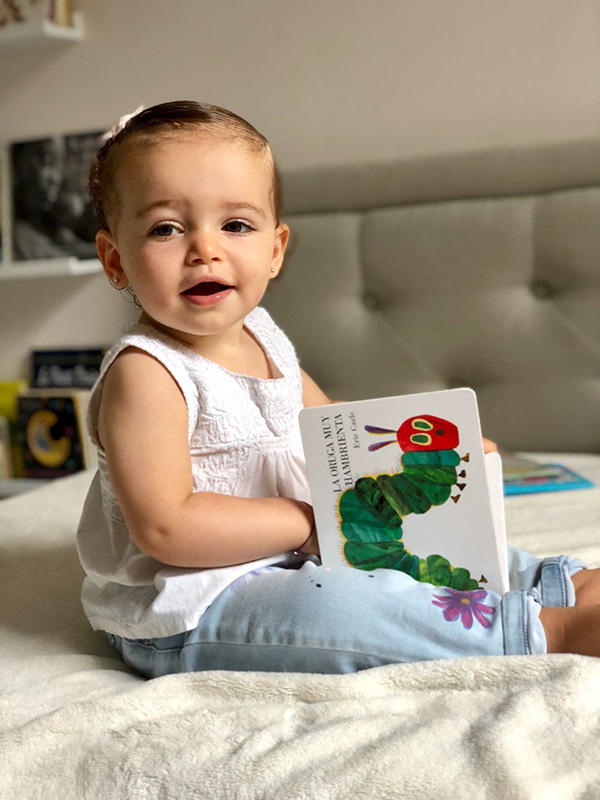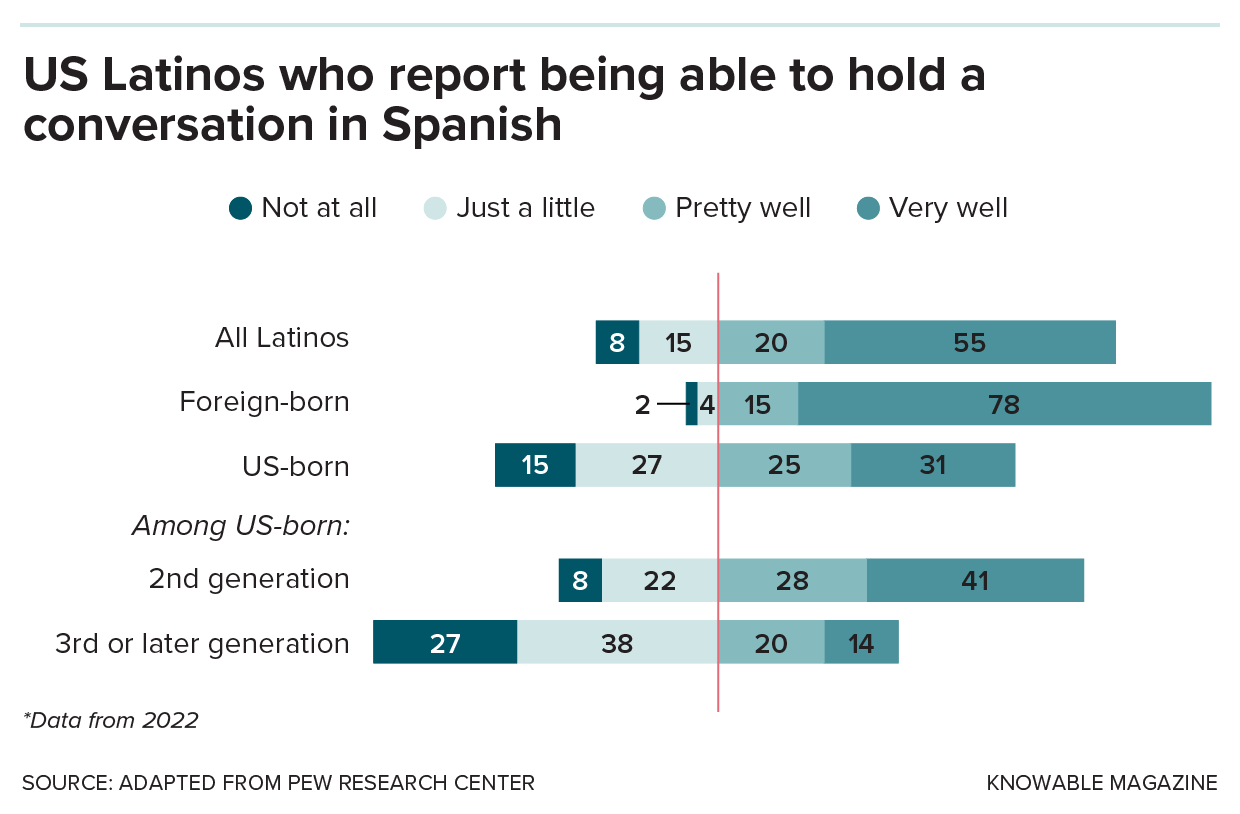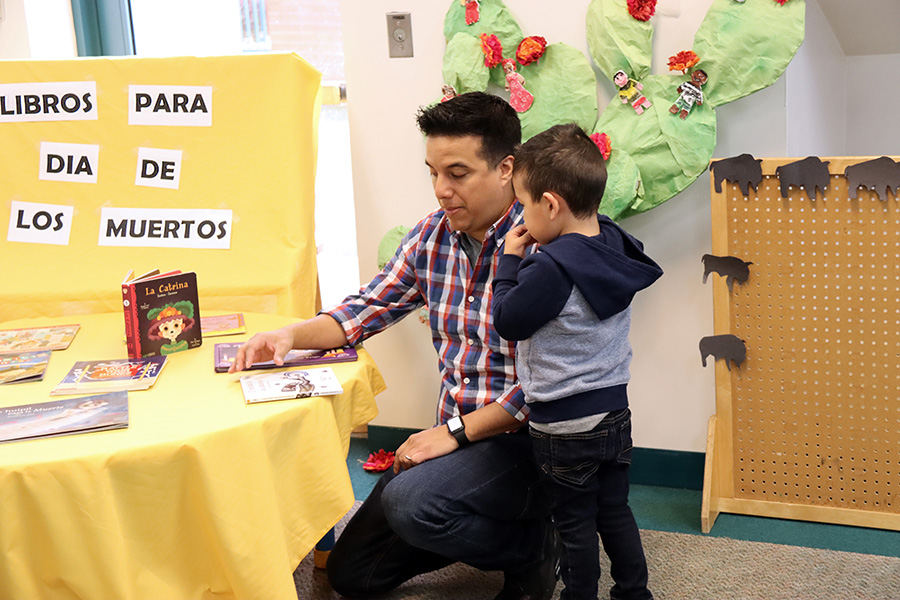How a child becomes bilingual — and what can be done to help them get there
Kids from immigrant backgrounds in the US often struggle to develop fluency in two languages. Many factors — parental misconceptions, the lack of support in schools and social attitudes — play a role.
Support sound science and smart stories
Help us make scientific knowledge accessible to all
Donate today
Adriana Weisleder knows well the benefits of being bilingual: being able to communicate with one’s community, cultivating connection with one’s heritage culture, contributing to the richness and diversity of society, and opening up professional opportunities. Research also suggests some cognitive benefits of bilingualism — such as improved multitasking — although those are more debated, says Weisleder, a developmental psychologist and language scientist of Costa Rican heritage who directs the Child Language Lab at Northwestern University near Chicago.
Nearly 22 percent of Americans speak a language other than English at home; many of them are English and Spanish speakers from immigrant families. Yet many children from immigrant families in the United States struggle to develop or maintain proficiency in two languages. Some may lose their heritage language in favor of English; others may fall behind in schools where their progress is evaluated only in English.
In a 2020 article in the Annual Review of Developmental Psychology, Weisleder and educational psychologist Meredith Rowe explain how a person’s environment — at a family, community and societal level — affects language acquisition. In the US, for instance, language development in children from immigrant families is influenced by parental misconceptions about raising children bilingually, a general scarcity of support for bilinguals in schools, and anti-immigrant sentiment in society more broadly.
In her research, Weisleder leads in-depth studies of bilingual toddlers in different social contexts to better understand how they comprehend and learn multiple languages. She hopes her insights will help to dispel misconceptions and fears around bilingualism and improve support for children learning multiple languages.
“It’s interesting theoretically, but also just really important for our society to have more information that can guide caregivers, education practitioners and clinicians on how bilingual children develop, and how to support them,” she says.
Knowable Magazine spoke with Weisleder about how children learn two languages, particular challenges faced by immigrant children in the US, ways to better support multilingualism, and her own experience with raising a 1½-year-old daughter bilingually. This interview has been edited for length and clarity.
What do we know about how infants exposed to two languages learn to speak? How does their language development differ from children only exposed to one language?
Bilingual children go through the same milestones of language development as monolingual children. Both start speaking their first words around one year of age, start combining words around six months or a year later, and eventually reach native proficiency. But we know that under all that, bilinguals are doing a more complex task of figuring out two linguistic systems. So we see a slightly more protracted development of some aspects of language.

The project Leyendo Juntos (reading together) at Northwestern University’s Child Language Lab encourages early reading activities in children and studies how this affects language interactions within Latino families.
CREDIT: COURTESY OF CHILD LANGUAGE LAB / NORTHWESTERN UNIVERSITY
One example is how bilingual children learn to differentiate sounds in their languages. For instance, in English, bile versus vile are different words, but in many varieties of Spanish, there isn’t a meaningful contrast between those sounds because b and v are interchangeable. Through lots of exposure to sounds, infants learn sound differences that are meaningful and lose the ability to identify differences that are not meaningful in their language. In bilingual children, it takes them a little bit longer to develop that discrimination and specialize in their languages.
For vocabulary, the rate of learning is also linked to the amount of language exposure. So what you’d expect is that for a young child that has 50 percent exposure to English and 50 percent to Spanish, their vocabulary in English will be about half of that of an English monolingual, and in Spanish it will also be about half. The really important thing, though, is that if you add their vocabulary in both languages together, then their rate of vocabulary development is the same as that of monolinguals.
For most aspects of language, bilingual children do eventually end up at the same place as monolinguals, even in a single language. In general, when 60 percent of a child’s total exposure to language has been in one particular language, they score about the same as a monolingual on most tests of that language. By the time they’re 3 or 4 years old — and certainly by school age — they’re looking very similar to monolinguals. That’s amazing, when you think about it — that you have two or maybe three languages, and you’re functionally the same as someone who speaks only one.
What’s really fascinating is that a lot of these characteristics also seem to be true of bilinguals who speak sign languages. So this learning process really is specific to language and not just speech.
What about “sequential bilingual” children, who learn one language after the other? Does their ability to do that depend on their age?
It depends a lot on age. If we’re talking about children who are learning two languages before, let’s say, seven years of age, they can become completely native speakers of those two languages, even if they’re learning them sequentially, although the process is a little bit different than for simultaneous bilinguals. Individuals who learn a language after this age — the exact age is hotly debated — usually don’t attain the same level of proficiency; that can mean speaking with an accent, or making some grammatical mistakes that are unusual for native speakers, for example.
Although there are also some adults that are able to learn languages very, very well, there’s no question that it’s easier to learn a language before adolescence than as an adult, but we don’t completely understand why.
Does someone’s knowledge and experience in one language affect how they understand and learn a second one?
Many things are specific to particular languages and don’t transfer. Learning the past tense in Spanish isn’t going to help me much to learn how to do it in English. But on the meaning side of language, for instance, what you learn in your first language helps. Let’s say I learned the Spanish words for cow, horse, pig and chicken. Those words are very specific to Spanish, but I also learned that all those are farm animals. Those kinds of connections between words are going to transfer to another language, so you’re not learning a whole new semantic system.
What about learning to read? Is that different from learning to speak?
Most scientists would agree that humans as a species are prepared to learn to speak a language, without having to be taught it explicitly. But our brains aren’t born prepared to learn to read; it’s something we have to teach ourselves. So things that apply to spoken language don’t necessarily apply to reading.
But what is true is that having a stronger foundation in oral language helps children learn to read better. We also know that when children are learning to read in a second language, the number of words they know in their first language is a predictor of their reading skills in the second language.
Tell me about your current research. What questions are you hoping to answer and how are you going about studying it?
We’re looking at how children understand and process language before they begin to speak. Studying comprehension is hard, though, because it happens in the mind.
We use eye-tracking to do this. There’s a special type of camera that tracks children’s eye movements as they’re looking at pictures or videos on a screen. If all of a sudden I say, “Oh look, a dog!” their eyes will immediately go searching for the dog. We can do different manipulations: Do they understand the difference between dog and cat, for example? What if I say dog and doll, which have similar sounds? Does that make it harder?
By doing these eye-tracking tasks in both the languages bilingual children are learning, we can ask questions like: How does their language processing ability in one language relate to their language processing in the other? And how does this change over time as they get more exposure to one language or the other?

Adriana Weisleder’s lab uses eye-tracking to study early language development in bilingual children; by monitoring their eye movements as children watch images on a screen, researchers can track how quickly they process sounds and words that relate to particular images.
CREDIT: COURTESY OF CHILD LANGUAGE LAB / NORTHWESTERN UNIVERSITY
Another reason we’re doing this is to find early measurements of language processing that can help identify children with language impairments, so we can give them speech and language therapies at a time when we think they’re going to benefit most from it.
One thing we’ve learned so far is that bilingual children seem to show some of the same signatures of language processing that monolingual children do. One concrete example is that they’re doing what we call “incremental processing” of speech. You actually don’t wait until the very end of a word or sentence to interpret it; you’re kind of doing it as the speech unfolds. If I show you a picture of a dog and a baby, the minute you hear the sound of a d — “duh” — if you’re looking at the baby, you’re going to shift over to look at the dog.
Incremental processing of language is a sign of maturity in language processing, and can help predict later language and cognitive development. We know that monolingual toddlers or infants do this incremental processing early on. And our studies are showing that bilingual children do it too, at least in their more dominant language. It may take them longer for the language that they have less exposure to.
It seems that children are generally very capable of learning to speak multiple languages they’re exposed to. Is this widely appreciated among parents, especially those from immigrant families? Are there any concerns you’ve encountered around raising children bilingually?
Unfortunately, there are a lot of misconceptions about bilingualism. What we hear from parents — especially Latino immigrant parents in the US — is that, on the one hand, there’s a desire for children to speak their home languages and to be bilingual. But at the same time, the parents have some fears that this will confuse their child or cause them to not learn English as well, and that that might hold their child back in key, important ways.
What actually plays the biggest role in discouraging parents from teaching their home languages is that in schools their children will be evaluated only in English.

During the Annual Hispanic Heritage Day Parade in 2019, marchers hold a banner with the statement “We speak Spanish” across Fifth Avenue in Manhattan.
CREDIT: PHOTO BY IRA L. BLACK / CORBIS VIA GETTY IMAGES
There are also some fears and experiences of discrimination against children when they speak their home languages. Especially during times where there’s lot of anti-Hispanic sentiment in the US, for instance, parents may hold back on efforts to teach their children Spanish, like enrolling in bilingual schools.
Misconceptions also exist among some professionals. We’ve found in surveys and interviews with pediatricians that while they often agree that bilingualism can be beneficial for children, they’ll express some hesitancy when asked, for instance, whether speaking another language could make it harder for a child to learn English. I think when pediatricians observe that bilingual children seem not to be acquiring English at the same rate as monolingual children, that makes them fearful about whether they should recommend that parents speak their home language.
We also see pediatricians get nervous when it comes to children with developmental disabilities or communication difficulties. But the research suggests that children with disabilities are also able to learn two languages; bilingualism doesn’t exacerbate their difficulties.
I imagine that this could contribute to the loss of heritage languages among immigrant families in the US. A Pew Research Center survey from 2023 found that one of every four Latinos in the US say they can only carry on a conversation in Spanish a little or not at all, and the numbers grow significantly when you are focusing on only third- or later-generation Latinos. What other factors contribute to that?
In the US, languages other than English are rarely supported in schools or by society in general. Those languages are treated as lower status, and this is particularly true for languages associated with immigrant communities such as Hispanics. So it ends up being up to parents or families to do all the work of supporting both languages. But the way that’s most natural for children to learn language is by actively communicating with peers and friends, not just family.
So sometimes children simply don’t use their heritage language as much, and they lose it over time. Other times they prefer English because it’s the language that helps them the most to communicate in the world — and sometimes they even actively reject their heritage languages. Children don’t want to be labeled as “different,” and language is just one other way in which other children can exclude them.

A survey of US Latinos found that most of them (75 percent) say they can hold a conversation in Spanish. But among third- or later-generation Latinos, a much larger share are not fluent: Close to two-thirds (65 percent) report not being able to converse well in Spanish.
I read in your review that bilingual children from Hispanic households in the US often report relatively lower academic outcomes relative to monolinguals, which contrasts with places like Quebec, Canada, where most children become linguistically and academically competent in both English and French. Why is that?
There are many possible reasons for the lower academic outcomes observed in bilingual children from Hispanic households compared to monolinguals. Some are likely not related to bilingualism at all, as there are often differences between these groups in terms of socioeconomic status, parental education, access to high-quality early childhood education and other factors.
But to the extent that we think bilingualism plays a role, I think that when bilingual children are evaluated only in English — as they are in US schools — these tests can underestimate their knowledge and capacities. Another data point that supports this is that children from bilingual homes who go to dual-language schools — where children are truly immersed in multiple languages rather than just having a class on them — do not underperform their monolingual peers. To me, this suggests that bilingual kids can perform just as well academically as monolingual children but are perceived to be underperforming when assessments are done only in English.
In Quebec or other places where bilingualism is fully supported by families, schools and society more generally, children can become academically competent in both languages. But the US does not have that kind of context.
What can be done at the societal and educational level in the US to help children become or stay fluent in multiple languages?
In 2023, we published an article about this in Policy Insights from the Behavioral and Brain Sciences. One point we make is that we should really internalize that it’s a right for all children to have access to their own languages. Language diversity is something we should be committed to supporting because it will make our society richer.
More concretely, we need to support community-led programs — like some that I work with here in Chicago — that incorporate language, culture, art, music, and provide natural, fruitful contexts to support home languages. Having meaningful communication partners — not just your parents, but your friends, peers, teachers, other people — is a really important signal for children, providing motivation to speak the heritage language.

Son Chiquitos, a program of 18th Street Casa de Cultura in Chicago, offers Spanish immersion sessions for family and children. Community-led programs like this one that incorporate language, culture, art and music can provide children with the motivation to speak their heritage language.
CREDIT: PHOTO BY GINA GAMBOA
Dual-language schools are also an excellent way to support multilingualism. But unfortunately, what has seemed to happen in the US is that these schools tend to cater to higher socioeconomic status families who want their children to learn another language. So they’re not quite as much serving the needs of immigrant communities that could most benefit from them.
For schools more generally, we should also shift away from English-only standards for testing and focus on supporting and assessing children’s academic progress in ways that allow them to make use of multilingual skills.
Can you tell me a bit about your own experience in trying to raise a child bilingually, and any challenges you’ve experienced?
Although Spanish is my native language, I use English almost dominantly now and my husband and I mostly communicate in English. I try to speak to my daughter — who is 1½-years-old — exclusively in Spanish. But that’s just not always practical — like sometimes when we’re all together.
Although she does have some words in Spanish and she understands almost everything I say to her in Spanish, her vocabulary has advanced much faster in English. I try to acknowledge what she says in English and repeat it in English, but I also try to introduce some Spanish words so that hopefully she picks them up.
Another thing that we’ll try to do is to spend more time with my family and in Costa Rica, where I’m from; if she has more people around her speaking in Spanish, I think that that will help solidify some language in her.
Do you have any tips for other parents trying to raise their children in more than one language?
One important thing is finding ways of having deep, immersive, meaningful conversations with your child. I’ve tried to motivate my toddler to speak Spanish when playing with me and during high-quality bonding moments. What I try to avoid is to, for example, only use Spanish when I’m trying to discipline her.
I would really encourage parents to try to find bilingual books or books in their home languages. Books provide complex and diverse language to use, and stories to talk about. A recent study from my lab shows that Latino parents use more Spanish when reading bilingual books with their children. And once kids are a little bit older, using media to find fun and authentic content in your home language can also be helpful.
I hope what parents take away from this is that bilingualism is fascinating and cool and complex, and not something to be fearful of. It’s a wonderful asset for kids that, oftentimes, children themselves will only appreciate later on. But it can be really hard when you’re doing it on your own. I would encourage parents to find community that supports them in doing it.
This article is part of Knowable Magazine’s series exploring the work of Latino scientists and emerging research affecting the US Latino community, presented in English and Spanish, and supported by the Science and Educational Media Group at HHMI.
10.1146/knowable-102224-1
TAKE A DEEPER DIVE | Explore Related Scholarly Articles




